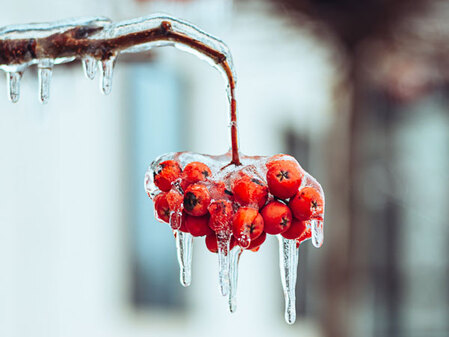|
Although our winters are usually mild here in Charleston, we do occasionally experience a hard freeze that can damage or even kill landscape plants. We've put together a few tips for avoiding plant damage and caring for plants after a freeze event. Preventing Cold DamageThe first and best way to guard against cold damage is to select plants that are appropriate for our growing region. Nearly all of the varieties we grow and stock at our nursery fall into this category. If temperatures are expected to be at or below freezing for an extended period - one or more hours - precautions taken to protect hardy landscape plants will lessen the likelihood of wilted or brown leaves and damaged flower buds. Prior to the arrival of freezing temperatures, add mulch to cover plant roots, water if there's been a lack of rainfall (be careful to water the root zone, not the foliage), and cover plants with a "frost cloth." Frost cloth can be purchased or fashioned from a bed sheet or thick black plastic. Be sure to cover plants to the ground and secure to prevent plants from being exposed to cold air/wind. Of course, it's hard to deny the beauty of certain colorful tropicals such as the Tropical Hibiscus. Tender plant varieties are often treated as annual container plantings throughout the warm season with the expectation that they may not survive a cold winter. However, these and other annual flowers can be protected from freezing temperatures by bringing them into a covered area such as a garage. If containerized plants are too heavy to move, water them in place and cover with a frost cloth. Note: Containerized plants left outside may not survive hours of cold exposure even if watered in and covered. Plant Care After a FreezeAfter a cold snap has passed, allow ice or snow to melt away naturally. It can take days or longer for cold damage to become visible. Freeze damage will likely present itself as wilted or brown leaves, browned and/or fallen flower buds, or splitting/cracks in the bark of shrubs and trees. Clean up cold damage on hardy perennial plants by removing any mushy, wilted foliage immediately. You may also strip crispy, brown foliage from deciduous woody ornamentals and trees at this time if desired. Resist pruning damaged shrubs and trees right away. Instead, wait until warmer weather arrives and temperatures have stabilized to prune away dead wood. This will prevent stimulating the plants to produce new growth too soon. Questions? The Nursery Professionals at our Garden Center are here to help! Email us at [email protected]. Please include any photos that may be helpful in answering your specific inquiry. Comments are closed.
|
Categories
All
Archives
June 2024
|


 RSS Feed
RSS Feed



